Abstract
During replication of polyoma DNA in isolated nuclei, RNA was found attached to the 5′ ends of growing progeny strands. This RNA starts with either ATP or GTP and can be labeled at its 5′ end with 32P from β-labeled nucleotides. Digestion of progeny strands with pancreatic DNase released 32P-labeled RNA that, on gel electrophoresis, gave a distinct peak in the position expected for a decanucleotide. We believe that this short RNA is involved in the initiation of the discontinuous synthesis of DNA and propose the name “initiator RNA” for it. The covalent linkage of initiator RNA to 5′ ends of growing DNA chains was substantiated by the finding that 32P was transferred to ribonucleotides by alkaline hydrolysis of purified initiator RNA obtained by DNase digestion of polyoma progeny strands synthesized from [α-32P]dTTP. While initiator RNA was quite homogeneous in size, it had no unique base sequence since digestion with pancreatic RNase of initiator RNA labeled at its 5′ end with 32P released a variety of different [32P]oligonucleotides. The switch from RNA to DNA synthesis during strand elongation may thus depend on the size of initiator RNA rather than on a specific base sequence.
Keywords: isolated nuclei, Okazaki fragments, RNA-DNA link
Full text
PDF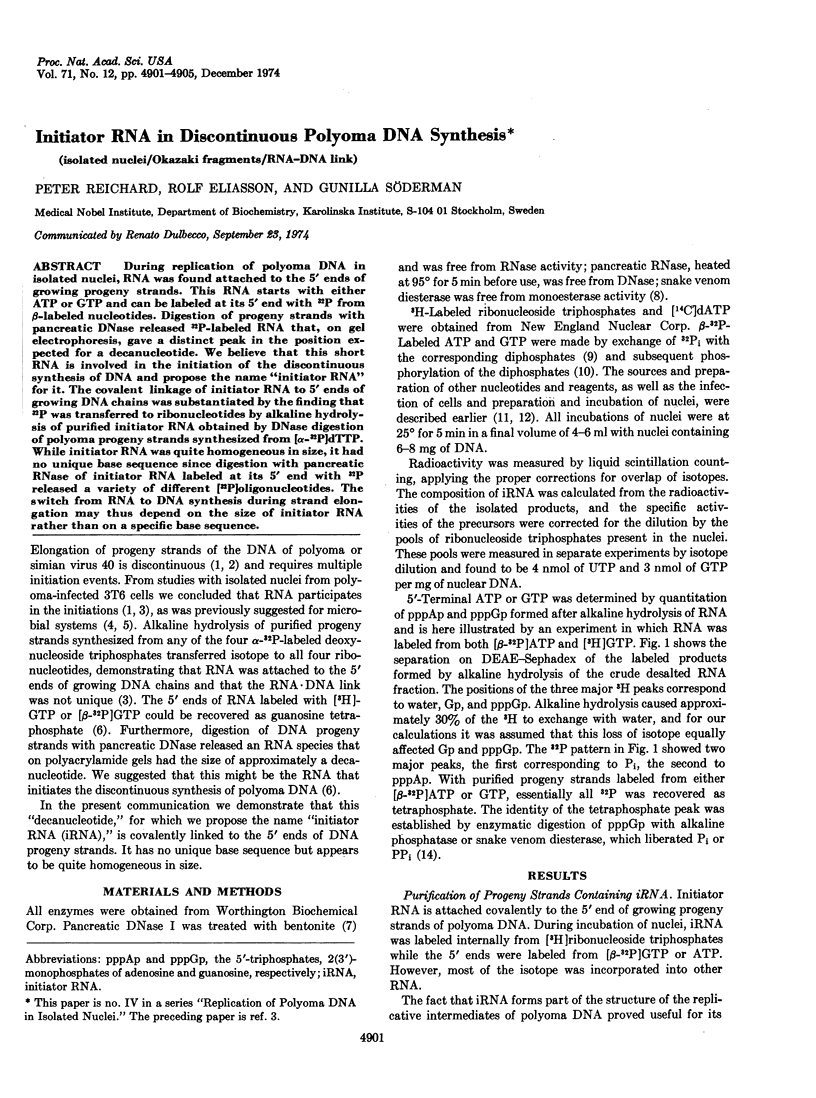
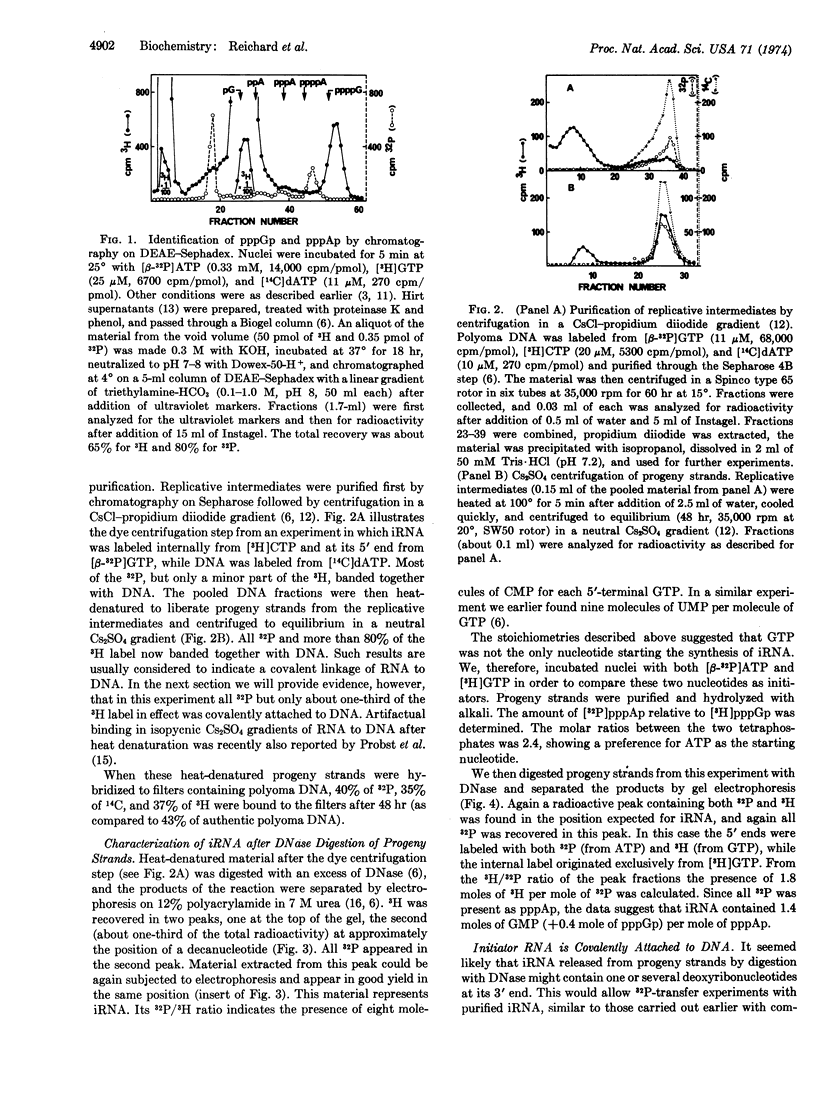
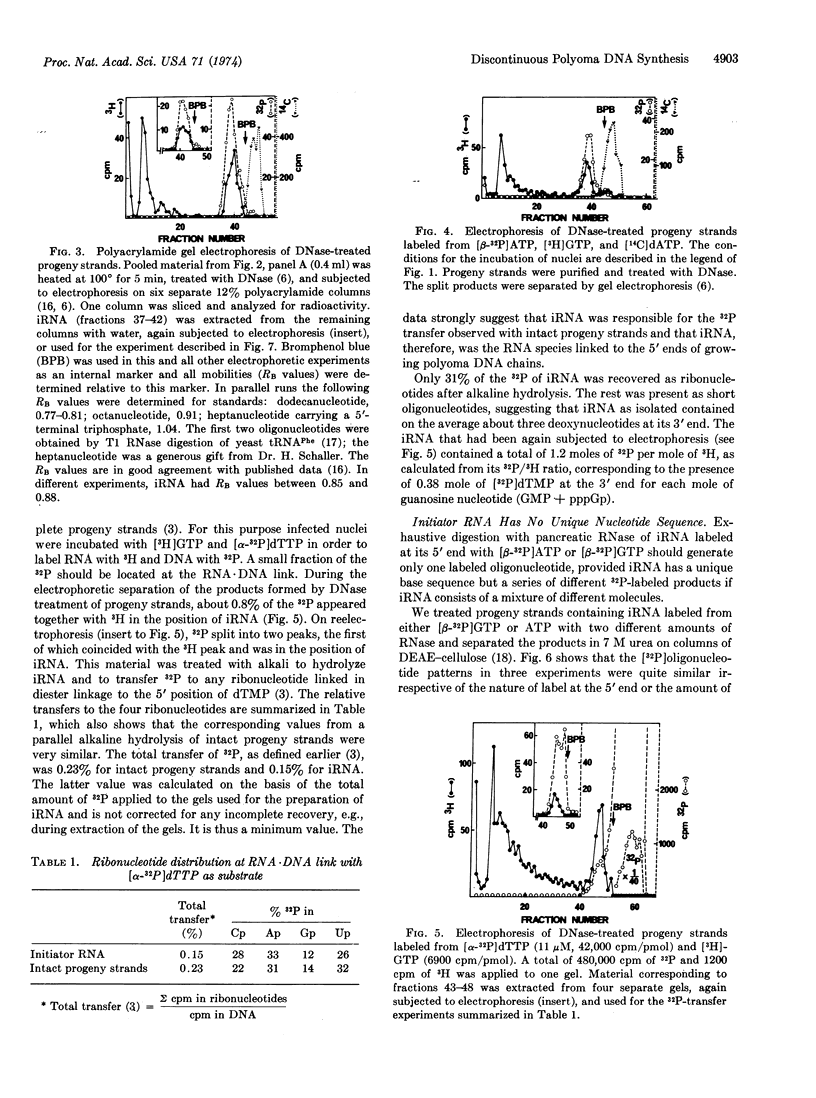
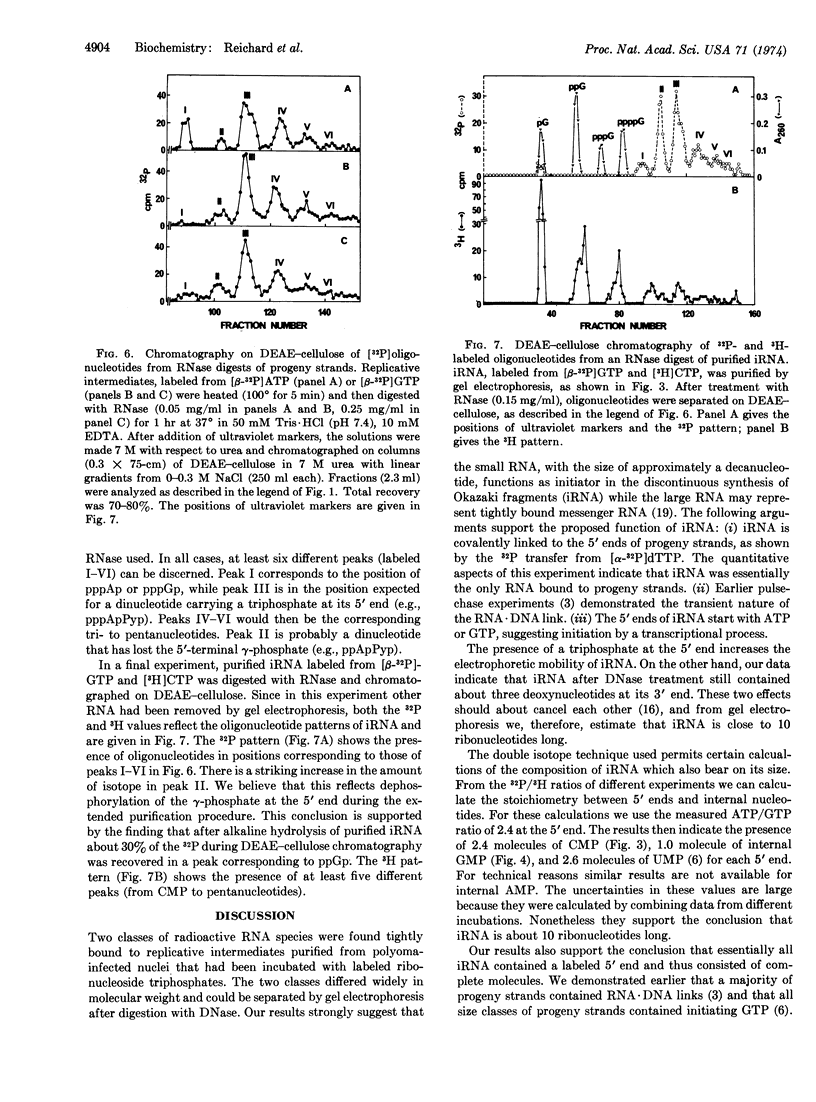
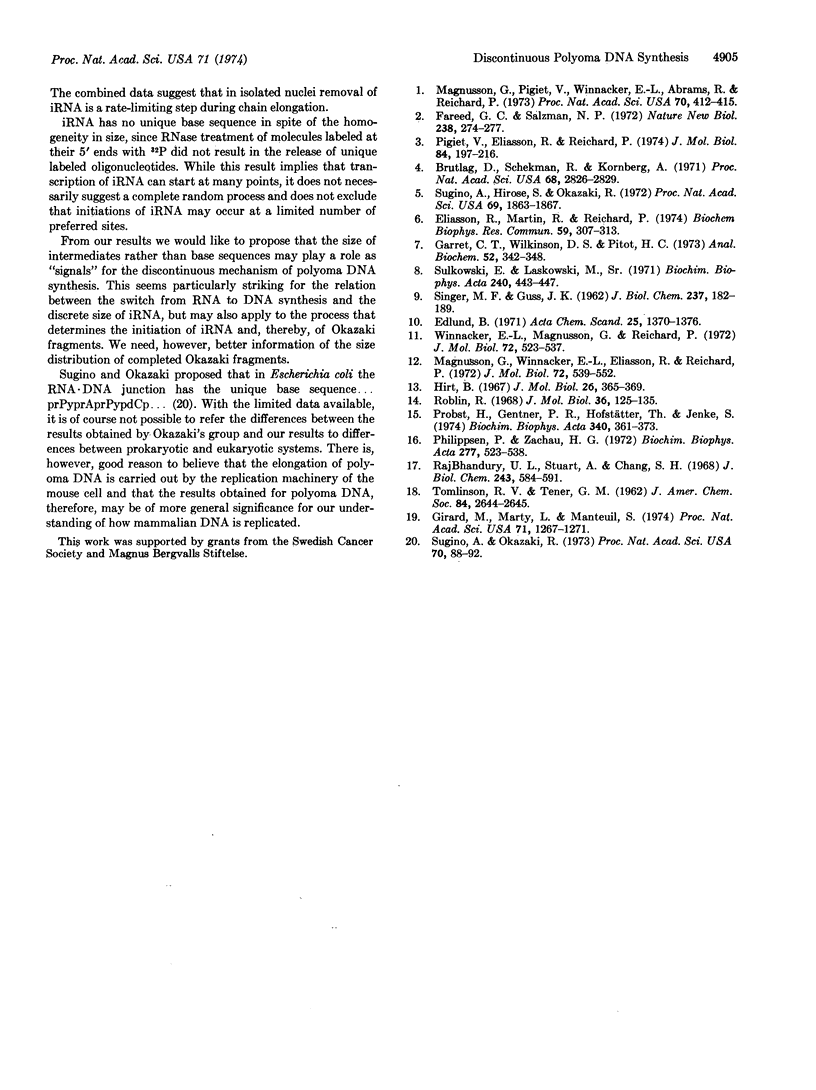
Selected References
These references are in PubMed. This may not be the complete list of references from this article.
- Brutlag D., Schekman R., Kornberg A. A possible role for RNA polymerase in the initiation of M13 DNA synthesis. Proc Natl Acad Sci U S A. 1971 Nov;68(11):2826–2829. doi: 10.1073/pnas.68.11.2826. [DOI] [PMC free article] [PubMed] [Google Scholar]
- Edlund B. Purification of a nucleoside diphosphate kinase from pea seed and phosphorylation of the enzyme with adenosine ( 32 P) triphosphate. Acta Chem Scand. 1971;25(4):1370–1376. doi: 10.3891/acta.chem.scand.25-1370. [DOI] [PubMed] [Google Scholar]
- Eliasson R., Martin R., Reichard P. Characterization of the RNA initiating the discontinuous synthesis of polyoma DNA. Biochem Biophys Res Commun. 1974 Jul 10;59(1):307–313. doi: 10.1016/s0006-291x(74)80207-x. [DOI] [PubMed] [Google Scholar]
- Fareed G. C., Salzman N. P. Intermediate in SV40 DNA chain growth. Nat New Biol. 1972 Aug 30;238(87):274–277. doi: 10.1038/newbio238274a0. [DOI] [PubMed] [Google Scholar]
- Garrett C. T., Wilkinson D. S., Pitot H. C. Preparation of ribonuclease-free DNase I and -amylase. Anal Biochem. 1973 Apr;52(2):342–348. doi: 10.1016/0003-2697(73)90035-3. [DOI] [PubMed] [Google Scholar]
- Girard M., Marty L., Manteuil S. Viral DNA-RNA hybrids in cells infected with simian virus: the simian virus 40 transcriptional intermediates. Proc Natl Acad Sci U S A. 1974 Apr;71(4):1267–1271. doi: 10.1073/pnas.71.4.1267. [DOI] [PMC free article] [PubMed] [Google Scholar]
- Hirt B. Selective extraction of polyoma DNA from infected mouse cell cultures. J Mol Biol. 1967 Jun 14;26(2):365–369. doi: 10.1016/0022-2836(67)90307-5. [DOI] [PubMed] [Google Scholar]
- Magnusson G., Pigiet V., Winnacker E. L., Abrams R., Reichard P. RNA-linked short DNA fragments during polyoma replication. Proc Natl Acad Sci U S A. 1973 Feb;70(2):412–415. doi: 10.1073/pnas.70.2.412. [DOI] [PMC free article] [PubMed] [Google Scholar]
- Magnusson G., Winnacker E. L., Eliasson R., Reichard P. Replication of polyoma DNA in isolated nuclei. II. Evidence for semi-conservative replication. J Mol Biol. 1972 Dec 30;72(3):539–552. doi: 10.1016/0022-2836(72)90173-8. [DOI] [PubMed] [Google Scholar]
- Philippsen P., Zachau G. Partial degradation of transfer RNAs and transfer RNA fragments by spleen phosphodiesterase as studied by disc electrophoretic methods. Biochim Biophys Acta. 1972 Sep 14;277(3):523–538. doi: 10.1016/0005-2787(72)90095-0. [DOI] [PubMed] [Google Scholar]
- Pigiet V., Eliasson R., Reichard P. Replication of polyoma DNA in isolated nuclei. 3. The nucleotide sequence at the RNA-DNA junction of nascent strands. J Mol Biol. 1974 Mar 25;84(1):197–216. doi: 10.1016/0022-2836(74)90222-8. [DOI] [PubMed] [Google Scholar]
- Probst H., Gentner P. R., Hofstätter T., Jenke S. Newly synthesized mammalian cell DNA: evidence for effects simulating the presence of RNA in the nascent DNA fraction isolated by nitrocellulose column chromatography. Biochim Biophys Acta. 1974 Apr 10;340(4):361–373. doi: 10.1016/0005-2787(74)90058-6. [DOI] [PubMed] [Google Scholar]
- RajBhandary U. L., Stuart A., Chang S. H. Studies on polynucleotides. LXXX. Yeast phenylalanine transfer ribonucleic acid: products obtained by degradation with ribonuclease T1. J Biol Chem. 1968 Feb 10;243(3):584–591. [PubMed] [Google Scholar]
- Roblin R. Nucleotides adjacent to the 5'-terminus of bacteriophage R17 RNA. J Mol Biol. 1968 Aug 28;36(1):125–135. doi: 10.1016/0022-2836(68)90224-6. [DOI] [PubMed] [Google Scholar]
- SINGER M. F., GUSS J. K. The dependence of reactions catalyzed by polynucleotide phosphorylase on oligonucleotides. J Biol Chem. 1962 Jan;237:182–189. [PubMed] [Google Scholar]
- Sugino A., Hirose S., Okazaki R. RNA-linked nascent DNA fragments in Escherichia coli. Proc Natl Acad Sci U S A. 1972 Jul;69(7):1863–1867. doi: 10.1073/pnas.69.7.1863. [DOI] [PMC free article] [PubMed] [Google Scholar]
- Sugino A., Okazaki R. RNA-linked DNA fragments in vitro. Proc Natl Acad Sci U S A. 1973 Jan;70(1):88–92. doi: 10.1073/pnas.70.1.88. [DOI] [PMC free article] [PubMed] [Google Scholar]
- Winnacker E. L., Magnusson G., Reichard P. Replication of polyoma DNA in isolated nuclei. I. Characterization of the system from mouse fibroblast 3T6 cells. J Mol Biol. 1972 Dec 30;72(3):523–537. doi: 10.1016/0022-2836(72)90172-6. [DOI] [PubMed] [Google Scholar]


